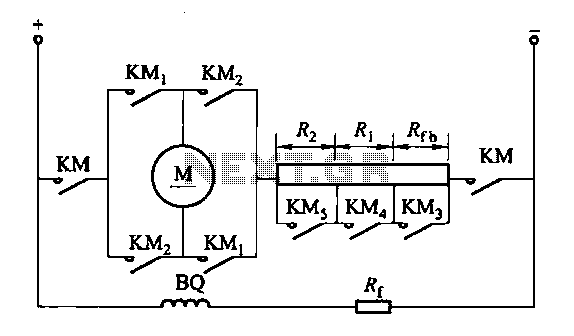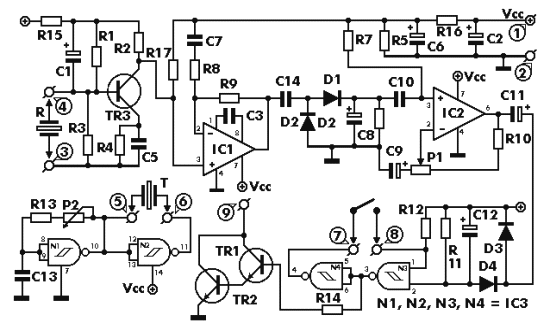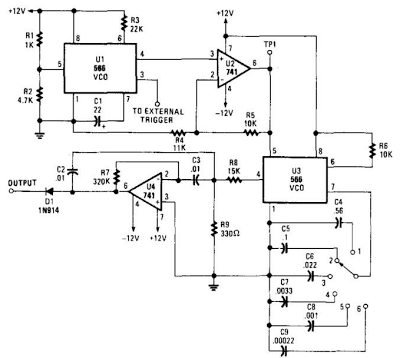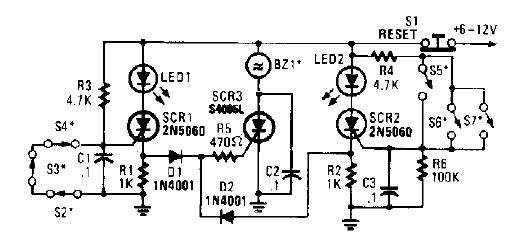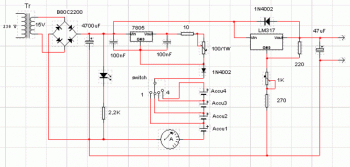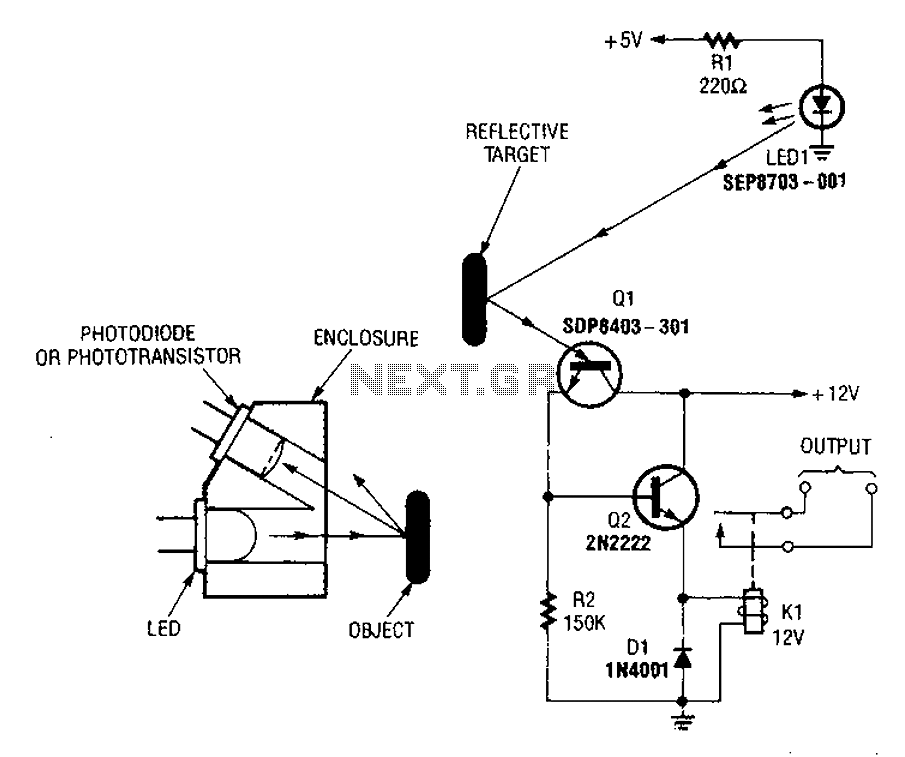
Gas stove flame alarm circuit
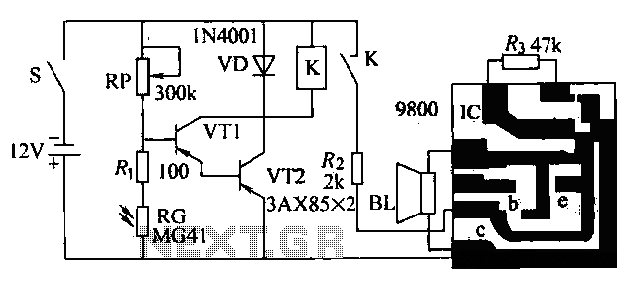
The circuit presented is a second-generation flame alarm for natural gas stoves. After the gas stove is ignited and normal combustion occurs, the power switch S is closed. The photoresistor RG, influenced by the light from the flame, has a low resistance, allowing transistors VT1 and VT2 to conduct. Consequently, relay K is activated, and its normally closed contact K remains open, preventing the music manifold IC from sounding. However, if the flame from the gas stove goes out, the light irradiation on RG significantly reduces, causing its resistance to increase. This leads to transistors VT1 and VT2 turning off, which releases relay K. The normally open contact K then closes, automatically powering the IC, which activates the speaker BL to issue a warning, reminding the user to close the gas valve. Additionally, the circuit specifies the use of a small relay JRX-13F, with an operating voltage of 12V. Transistor VT3 can be a 9014, and alternatives include 3DG4M, 3DG201, 3DG401, or 3DG8A. The sensitivity of the alarm can be adjusted using potentiometer RP.
The second-generation flame alarm circuit for natural gas stoves is designed to enhance safety by detecting the presence of flame during operation. The circuit operates by monitoring the light emitted from the flame through a photoresistor (RG). When the stove is ignited, RG's resistance decreases due to the light, allowing current to flow through transistors VT1 and VT2. This conduction keeps relay K engaged, maintaining the normally closed contact in an open state and preventing the alarm from sounding.
In the event that the flame is extinguished, the light on RG diminishes, leading to an increase in resistance. This change results in the cutoff of the current to VT1 and VT2, causing relay K to disengage. The normally open contact K then closes, supplying power to the integrated circuit (IC) that drives the alarm system. The activation of the speaker (BL) produces a sound to alert the user, prompting immediate action to close the gas valve and prevent potential hazards.
The choice of components is critical for the reliability of the circuit. The JRX-13F relay is selected for its compact size and 12V operation, which is suitable for most household applications. The transistors used, such as the 9014, are readily available and can handle the necessary current for the application. Alternative transistors like 3DG4M, 3DG201, 3DG401, and 3DG8A provide flexibility in component sourcing while maintaining circuit performance.
Furthermore, the presence of an adjustable potentiometer (RP) allows for fine-tuning of the alarm's sensitivity, enabling customization based on the specific environmental conditions or user preferences. This feature enhances the effectiveness of the alarm system, ensuring that it responds appropriately to flame presence or absence. Overall, this flame alarm circuit is a critical safety device that effectively monitors gas stove operation, providing timely warnings to prevent accidents.The circuit shown is the second natural gas (gas) stove flame alarm. After the gas stove ignited normal combustion, close the power switch S. Photoresistor RG due to irradiation by light flame, its resistance is small, the transistor VT1 and VT2 conduction, the relay K pull its normally II1 contact K off, music Manifold IC does not sound. But once the gas stove flame, RG by light irradiation greatly reduced, the resistance increases, the Vri and VTZ off, the relay K to release, normally open contact K is closed, automatically turn on the power IC's source, lC work, the speaker BL Music issued warning to remind the main person close the gas valve.
In addition to the circuit has been noted, a small relay selection JRX-13F, operating voltage of 12V. Transistor VT3 to 9014, available 3DG4M, instead of 3DG201,3DG401 or 3DG8A, B and so on. Adjustment potentiometer RP, can change the alarm sensitivity.
The second-generation flame alarm circuit for natural gas stoves is designed to enhance safety by detecting the presence of flame during operation. The circuit operates by monitoring the light emitted from the flame through a photoresistor (RG). When the stove is ignited, RG's resistance decreases due to the light, allowing current to flow through transistors VT1 and VT2. This conduction keeps relay K engaged, maintaining the normally closed contact in an open state and preventing the alarm from sounding.
In the event that the flame is extinguished, the light on RG diminishes, leading to an increase in resistance. This change results in the cutoff of the current to VT1 and VT2, causing relay K to disengage. The normally open contact K then closes, supplying power to the integrated circuit (IC) that drives the alarm system. The activation of the speaker (BL) produces a sound to alert the user, prompting immediate action to close the gas valve and prevent potential hazards.
The choice of components is critical for the reliability of the circuit. The JRX-13F relay is selected for its compact size and 12V operation, which is suitable for most household applications. The transistors used, such as the 9014, are readily available and can handle the necessary current for the application. Alternative transistors like 3DG4M, 3DG201, 3DG401, and 3DG8A provide flexibility in component sourcing while maintaining circuit performance.
Furthermore, the presence of an adjustable potentiometer (RP) allows for fine-tuning of the alarm's sensitivity, enabling customization based on the specific environmental conditions or user preferences. This feature enhances the effectiveness of the alarm system, ensuring that it responds appropriately to flame presence or absence. Overall, this flame alarm circuit is a critical safety device that effectively monitors gas stove operation, providing timely warnings to prevent accidents.The circuit shown is the second natural gas (gas) stove flame alarm. After the gas stove ignited normal combustion, close the power switch S. Photoresistor RG due to irradiation by light flame, its resistance is small, the transistor VT1 and VT2 conduction, the relay K pull its normally II1 contact K off, music Manifold IC does not sound. But once the gas stove flame, RG by light irradiation greatly reduced, the resistance increases, the Vri and VTZ off, the relay K to release, normally open contact K is closed, automatically turn on the power IC's source, lC work, the speaker BL Music issued warning to remind the main person close the gas valve.
In addition to the circuit has been noted, a small relay selection JRX-13F, operating voltage of 12V. Transistor VT3 to 9014, available 3DG4M, instead of 3DG201,3DG401 or 3DG8A, B and so on. Adjustment potentiometer RP, can change the alarm sensitivity.
